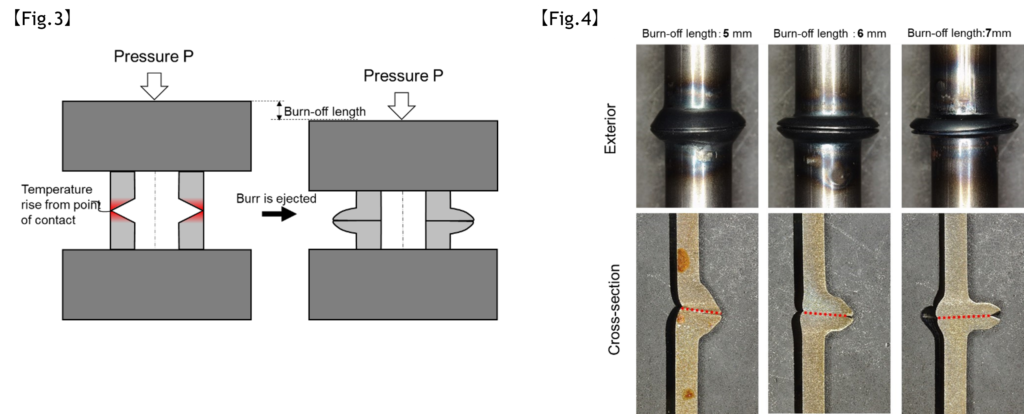Summary
- A technology that joins materials such as round or square bars and pipes by applying an electric current while applying sufficient pressure to the joint area, heating the joint surface with Joule heat, and joining the materials.
- By applying the appropriate pressure, it is possible to join materials even when the temperature of the joint surface is below the A1 point, where no crystalline transformation occurs, and the solid phase joining technology can maintain the same hardness as the base material. The temperature of the joint surface can be controlled by the current value.
- Side-electrode-based joining, which uses a side electrode to apply current to the joint from the side, enables joining with a small current value.
- This technology can be used to join pipes and hollow materials without burrs on the inner walls, and it can also be used to join dissimilar materials.
- We propose the introduction of this technology to manufacturers of joining equipment and companies in the automotive and railway industries that use joining equipment.
Technology Overview & Background
Conventionally, the most common method of joining materials together has been to use the friction heat generated by sliding or rotating the materials at high speed (friction welding, linear friction welding). However, this method has the problem that the friction heat becomes very high, which degrades the strength of the joint, and also the fact that the sliding and rotating mechanisms required mean that the joining machinery becomes large and complex.
In order to address these issues, the inventors focused on a method that uses external heat input rather than friction heat as the heating source for joining. Specifically, they developed a method that uses Joule heating by passing an electric current through the joining surface (resistance welding) (Figure 1). With this method, applying sufficient pressure when passing an electric current makes it possible to join the surfaces while keeping the temperature below the crystalline transformation point (A1 point), preventing any deterioration in the strength of the joining surface. In addition, this method does not require large equipment.
Furthermore, we have developed a method that uses electrodes that come into contact with the side of the material to be joined and applies current from the side, allowing heat to be applied to large diameter materials at low power and to the required temperature (Figure 2). With this method, even in the case of joining dissimilar materials with different thermal conductivity, sufficient heat can be applied while avoiding defects in the joint by adjusting the position of the electrodes.
Using this method, we have also developed a method for joining pipes and hollow materials that are strong but do not have burrs on the inside. By machining the end faces of pipes and hollow materials to a tapered shape from the outside to the inside (Figure 3), and then joining them using resistance welding, it is possible to manufacture strong pipes and hollow materials with almost no burrs on the inside.
Data
- We created a round bar made of carbon steel JIS-S45C and joined it by applying a current of 2000 to 4000A to this material while joining it at 250 MPa. As a result, it was found that it takes about 1 to 10 seconds to join 2 mm of material, and that the higher the current density applied to the material (applied current/cross-sectional area of material), the shorter the joining time and the higher the joint efficiency. In the best experimental case, the joint was equivalent to the strength of the base material, and a good joint was obtained with no defects or softening due to heat effects.
- Using pure aluminum and pure copper round bars (5 mm in diameter), the electrodes were made to contact the copper material at a right angle to the contact surface, and current was applied to make a pressure joint. The performance of this joint was 96% joint efficiency in a tensile test.
Patent(s)
WO/2023/021945 (Japanese)
Researchers & Academic Institution
Hidetoshi Fujii, PhD (Professor, Research Division of Materials Joining Mechanism, Joining and Welding Research Institute, The University of Osaka, Japan), et al.
Expectations
- If you would like to develop a joining device that uses this technology, we can propose developing the device in collaboration with The University of Osaka. We can also provide technical guidance for practical use.
- If you need a joining device that uses this technology (such as in the automotive or railway industries), please get in touch. We can propose a system for joint research and development with The University of Osaka to see if the metals used by your company can be joined.
We can also arrange a meeting with the researchers to discuss this invention/project, so please feel free to contact us if you would like to do so.
 |
 |
Project No.DA-02564a


